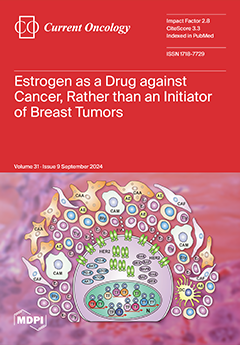Background: Prostate cancer (PCa) management commonly involves the utilization of prostate radiotherapy (PRT), pelvic nodal radiotherapy (PNRT), and androgen deprivation therapy (ADT). However, the potential association of these treatment modalities with bone marrow (BM) suppression remains inadequately reported in the existing literature. This
[...] Read more.
Background: Prostate cancer (PCa) management commonly involves the utilization of prostate radiotherapy (PRT), pelvic nodal radiotherapy (PNRT), and androgen deprivation therapy (ADT). However, the potential association of these treatment modalities with bone marrow (BM) suppression remains inadequately reported in the existing literature. This study is designed to comprehensively evaluate the risk of myelosuppression associated with PRT, shedding light on an aspect that has been underrepresented in prior research. Materials and Methods: We conducted a retrospective analysis of 600 patients with prostate cancer (PCa) treated with prostate radiotherapy (PRT) at a single oncology center between 2007 and 2017. Patients were categorized into four cohorts: PRT alone (n = 149), PRT + ADT, (n = 91), PRT + PNRT (n = 39), and PRT + PNRT + ADT (n = 321). To assess the risk of myelosuppression, we scrutinized specific blood parameters, such as hemoglobin (HGB), white blood cells (WBCs), neutrophils (NEUT), lymphocytes (LYM), and platelets (PLT) at baseline, mid-treatment (mRT), immediately post-RT (pRT), 1 month post-RT (1M-pRT), and 1 year post-RT (1Y-pRT). The inter-cohort statistical significance was evaluated with further stratification based on the utilized RT technique {3D conformal radiotherapy (3D-CRT), and intensity-modulated radiation therapy (IMRT)}. Results: Significant statistical differences at baseline were observed in HGB and LYM values among all cohorts (
p < 0.05). Patients in the PRT + PNRT + ADT cohort had significantly lower HGB at baseline and 1M-pRT. In patients undergoing ADT, BMS had a significant impact at 1M-pRT {odds ratio (OR) 9.1; 95% Confidence Interval (CI) 4.8–17.1} and at 1Y-pRT (OR 2.84; CI 1.14–7.08). The use of 3D-CRT was linked to reduced HGB levels in the PRT + PNRT + ADT group at 1 month pRT (
p = 0.015). Similarly, PNRT significantly impacted BMS at 1M-pRT (OR 6.7; CI 2.6–17.2). PNRT increased the odds of decreased WBC counts at 1Y-pRT (OR 6.83; CI: 1.02–45.82). Treatment with any RT techniques (3D-CRT or IMRT), particularly in the PRT + PNRT and PRT + PNRT + ADT groups, significantly increased the odds of low LYM counts at all time points except immediately pRT (
p < 0.05). Furthermore, NEUT counts were considerably lower at 1M-pRT (
p < 0.05) in the PRT + PNRT + ADT group. PLT counts were significantly decreased by PRT + PNRT + ADT at mRT (OR 2.57; 95% CI: 1.42–4.66) but were not significantly impacted by the RT technique. Conclusions: Treatment with PRT, ADT, PNRT, and 3D-CRT is associated with BMS. Despite this statistically significant risk, no patient required additional interventions to manage the outcome. While its clinical impact appears limited, its importance cannot be underestimated in the context of increased integration of novel systemic agents with myelosuppressive properties. Longer follow-up should be considered in future studies.
Full article






